Resources for Writers
An assortment of goodies and links for fellow writers
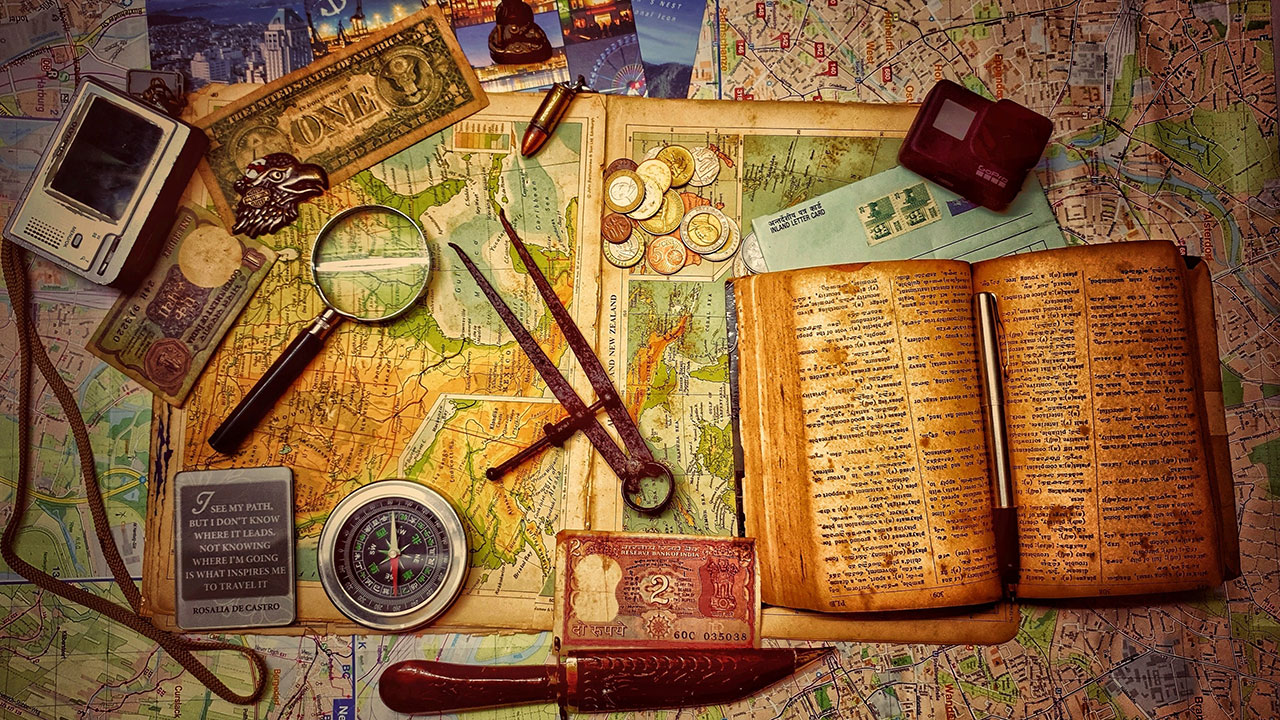
The resources you see here are not exhaustive. I've either personally used them, or they were recommended to me. I have more in the queue awaiting me to take a look at them, or gather up the necessary assets (links, images, whatever). If you think something belongs here, do let me know and I'll take a look.
What's here are includes Scrivener templates, beat sheets, and other software. Plus books, websites, and YouTube channels.
Scrivener Templates
Plot Structure
-
Lester Dent's Pulp Fiction Template

Back in the day, Lester Dent wrote the Doc Savage novels, and a multitude of short stories. He created a formula for writing short pulp fiction, but I included a post from Michael Moorcock where he explained how he adapted the math for his Elric novels.
For an explainer on the formula or Moorcock's adaptation, see this post at BlackGate.com.
-
K.M. Weiland's Story Structure Template
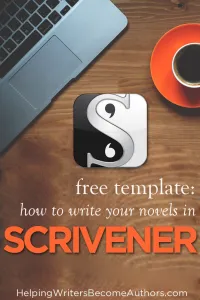
This is the one I generally use as my baseline for Scrivener projects. Includes sections for worldbuilding and outlining.
Genre-Specific Scrivener Templates
-
Murder Mystery Template

I combined two Scrivener templates, one from Mel Corbett that I had to retrieve from the Wayback Machine, and one from author Jennifer Mattern. What’s in the Draft folder comes from Corbett. All the other folders come from Mattern, with the following exceptions: Back Matter, Unplaced / Deleted Scenes, Critiques, and Reviews. I also added the Logline document in Mattern’s Promotional Material folder. I saved this version to Scrivener's forums on the chance they would not be lost.
-
Romancing the Beat -- Scrivener Template

This template comes from Gwen Hayes, and is a companion to her book with the same name. The template is color coded and ready for you to download to your computer.
Outlining / Planning
-
Caroline Norrington's Novel Outliner Template

Norrington says this template is for prepping a novel and it’s quite detailed, so it won’t suit everyone. It’s a structure and a series of worksheets for coming up with ideas, developing those ideas with plot, character, themes etc., and keeping track of them all in a logical order.
-
Writer's Notebook
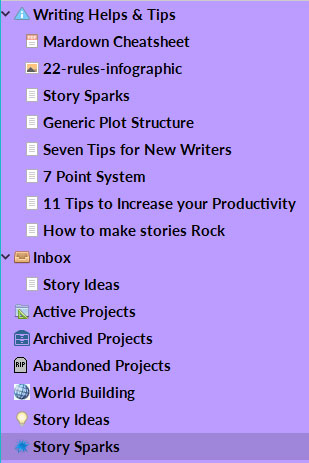
This comes from Belinda Crawford's site. She says she found it at a now-defunct site (there's a lot of that going around). It has folders for worldbuilding, documents on the 7-Point Story Structure, advice from Kevin J. Anderson, V.S. Naipaul, etc., etc.
Scrivener Story Bible
-
World Building Leviathan
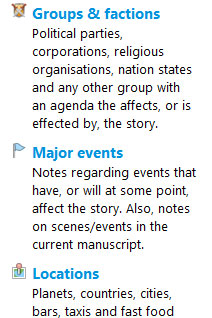
Belinda Crawford links to this, and a Spanish version. I agree with her caveats concerning it, but the Leviathan can be an excellent base for rolling your own story bible. It may also be useful as a starting point for an RPG design document.
-
TV Episode with Show Bible and Pitch

A user-created template for a 1 hour TV show script format that also incorporates a Series Bible with instructions/descriptions, and a blank pitch booklet with templates the user found helpful in the past. Plus directions and theory for the Series Bible from some of the top screenwriting sources on the internet, so you know in detail what to do with each section and how to build your Series Bible.
RPG templates
-
How to Use Scrivener as a Campaign Binder
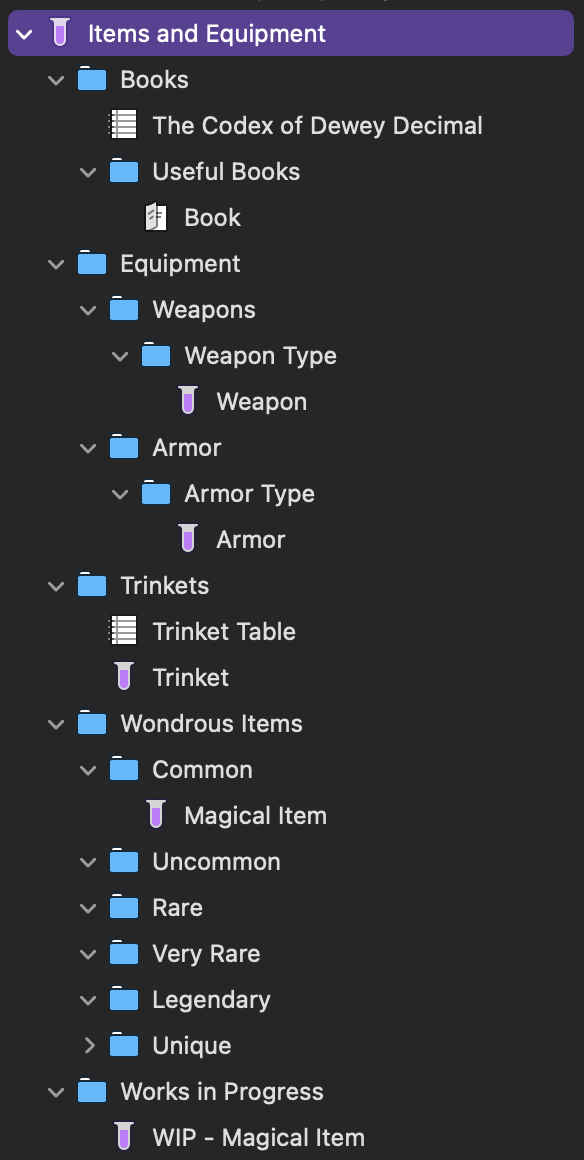
Free template from Graycastle Press, with a walkthrough in the event you want to roll your own. You do have to sign up to get the template, but it's otherwise free.
-
Scrivener Template for D&D 5e
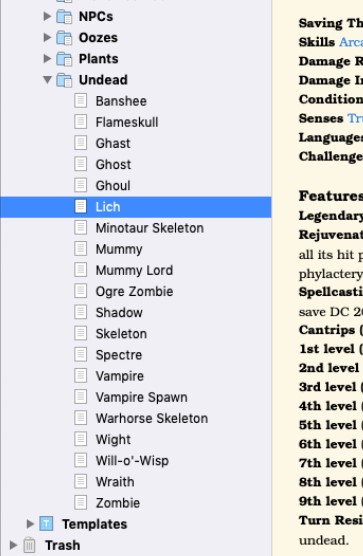
This project includes a Scrivener template file for MacOS and Windows, as well as a free font, "Tex Gyre Bonum." It is designed to help organize and design game worlds as well as offering a good experience while playing D&D; 5th Edition. Most of the currently available SRD rules are included or on their way to be released in the template.
Beat Sheets
A word about beat sheets
You’ll notice the structural beat sheets have page numbers where certain events are expected to occur based on the word count. Don’t stress about the page numbers when you're writing the story. This is for editing / revisions, when you're focused on pacing.
Consider: let’s suppose the Fellowship of the Ring is 300 pages. The central issue is that Sauron is after the One Ring in order to take over Middle Earth. Frodo agrees to the mission to destroy that ring. In that scenario, Frodo shouldn’t just be learning of the ring’s existence on page 150. By the halfway point he should already be about the business of dealing with the ring. If it takes half the book for Frodo to learn of the ring’s existence, then the story is likely slow and meandering.
If Cinderella is 300 pages, she likely doesn’t go to the ball on page 30. Page 30 puts the ball in the first 10% of the story, which is too rushed to show how awful her stepfamily is, and to show her striving to make a dress before those wicked shrews destroy it.
The point of pacing is to keep the story from being slow and dragging, or being too rushed and sloppy. Everything should unfold at the right time. Recall Gandalf’s admonition that a wizard is never early, nor is he late: he always arrives precisely when he needs to. Same deal for structural plot points in a story.
The beat sheets are to help with editing or revisions. You might plan what your beats are before you write (so your sheet might be used that way), but in revisions you may add, cut, or streamline scenes. You might trim extraneous words, let alone add necessary words!
Note well, there's a difference between a narrative beat and a structural beat. Structural beats aren't skippable and must occur at certain points: inciting incident, midpoint, climax, etc. But narrative beats can be repeated, skipped, or placed where they make the most sense. The Meeting the Mentor beat might happen repeatedly, as for instance in Avatar: the Last Airbender where Aang aquires multiple mentors.
The point is to recognize these tools for what they are: support guides, not strait jackets.
-
Jami Gold's Worksheets for Writers
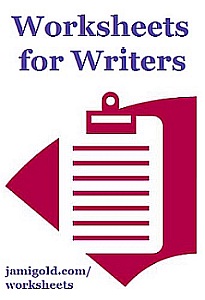
On this page you will find an assortment of beat sheets, including sheets based on: Story Engineering by Larry Brooks, Save the Cat by Blake Snyder (plus a combo version based on both), Gold’s own romance beat sheet, and Michael Hauge’s six-stage plot structure beat sheet. Just scroll down, and you will see an assortment of other useful worksheets.
-
Descent of Inanna Beat Sheet
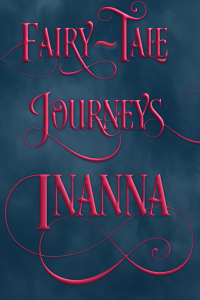
Click the link below to download beat sheet for the Descent of Inanna Journey. I adapted it from "45 Master Characters " by Victoria Lynn Schmidt. In the zip file you will find a PDF, two Word files (.doc and .docx) and a Pages file.
Beat Sheet: Inanna's Descent
For more on this journey, see my post, Facing Your Demons - Inanna's Descent
-
Demeter and Isis Beat Sheet
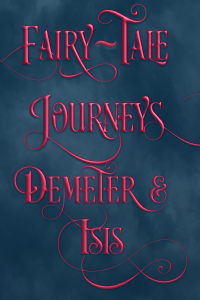
Click the link to download the beat sheet for the Demeter & Isis reunification journey. I adapted it from "The Heroine's Journey " by Gail Carriger. In the zip file you will find a PDF, two Word files (.doc and .docx) and a Pages file.
Beat Sheet: Reunification Journey
For more on this journey, see my post, The Reunification Journeys of Demeter & Isis
-
Penelope's Path Beat Sheet
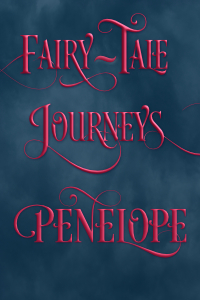
Click the link to download the beat sheet for Penelope's path. I adapted it from the beat sheet Kim Hudson included in "The Virgin's Promise." In the zip file you will find a PDF, Word (.doc and .docx) and a Pages document.
Beat Sheet: Penelope's Path, a Fairy-Tale Journey
For more on this journey, see my post, Dreams & Stratagems: Penelope's Journey
-
Psyche's Descent Beat Sheet

Click the link to download the beat sheet for the Psyche's classic fairy-tale journey. I adapted it from posts by Theodora Goss and Ookami Kasumi. In the zip file you will find a PDF, two Word files (.doc and .docx) and a Pages file.
Beat Sheet: Psyche's Classic Fairy Tale Journey
For more on this journey, see my post, The Classic Fairy-Tale Journey: Psyche's Descent
Character Resources
You'll find here a mix of aids for creating vivid characters. Everything from writing archetypal characters, to naming characters and character questionnaires.
Writing Archetypal Characters
-
The Hero With a Thousand Faces
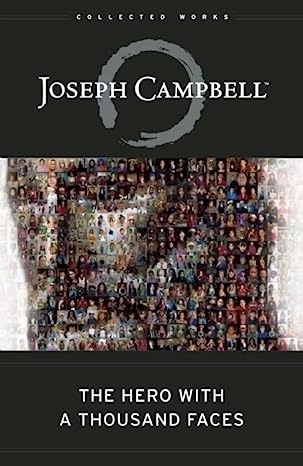
Joseph Campbell The book that started it all, here is the source material for the very concept of the Hero's Journey. Here you will find Gilgamesh and Inanna, Odysseus and Psyche, and insight into the actual purpose of the famous "Refusal of the Call" that so many misunderstand.
You really ought to read this just to truly understand the what's actually at play in the Hero's Journey, and so you can use it appropriately. Once you read this book, scroll down for Vogler's version, "The Writer's Journey."
-
The Heroine's Journey: For Writers, Readers, and Fans of Pop Culture

Gail Carriger Carriger explores a version of the fairy tale journey based on the quests of Isis and Demeter, both of whom were seeking to reunite with a loved one who was taken from them. Isolation brings peril, and success in this quest requires forging new alliances. Along the way, the Journeyer improves the lives of others.
Though Carriger apparently believes this journey is not valued, it is used to great success in video games and any story where an ensemble of heroes work as a team.
-
King, Warrior, Magician, Lover: Rediscovering the Archetypes of the Mature Masculine

Robert Moore and Douglas Gillette Four mature male archetypes stand out through myth and literature across history: the king (the energy of just and creative ordering), the warrior (the energy of aggressive but nonviolent action), the magician (the energy of initiation and transformation), and the lover (the energy that connects one to others and the world). As well, four immature patterns interfere with masculine potential: divine child, oedipal child, trickster, and hero.
I appreciated their insight regarding the passive and aggressive sides to a given archetype. As well, they underscore the Hero archetype is a youthful one, and the arc is a coming of age journey that one is supposed to arc out of, into a more mature path.
-
The Virgin's Promise: Writing Stories of Feminine Creative, Spiritual and Sexual Awakening

Kim E. Hudson In the cocoon of the Kingdom the Virgin is stunted from growth, unable to realize cherished dreams. Until one day, a chance comes to make those dreams come true. The catch is that he or she must operate in secret. But secrets have a way of coming out ...
The Hero of the Mythic Journey is frequently a love interest of the Journeyer on this path, and the two of them may come of age together. This book also includes descriptions of archetypes who may appear in this journey.
-
Inanna: Queen of Heaven and Earth | Her stories and Hymns from Sumer

Diane Wolkstein, and Samuel Noah Kramer You will find several of the books in this line-up reference Inanna's journey; this translation is the source material. Worth it for the in-depth look at this earliest version of the fairy tale journey, aka the Heroine's Journey. As well, the translators provide background information on Inanna and stories concerning her.
-
45 Master Characters: Mythic Models for Creating Original Characters
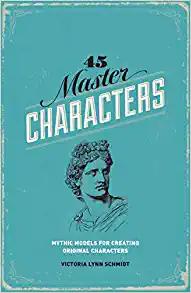
Victoria Lynn Schmidt This book explores 24 archetypes, 12 for men and 12 for women. Schmidt notes which archetypes are likely to get along, and which ones may figure as villains to another. In addition she outlines the Hero's Journey and the Heroine's Journey.
The Heroine's Journey outlined here is based on the Descent of Inanna as translated by Wolkstein and Kramer. It's a versatile journey that lends itself well to mysteries, thrillers, horror, and redemption arcs.
Additional: The Heroine's Journey Series -
A Writer's Guide to Characterization: Archetypes, Heroic Journeys, and Other Elements of Dynamic Character Development

Victoria Lynn Schmidt A companion to 45 Master Characters, she goes deeper into the archetypes, their villainous sides, and how they relate to each other, especially in the realm of romance. Further, she details archetypal journeys that may test these archetypes. Download the quizzes below to see which archetype your hero or heroine falls into.
Heroine Questionnaire
Hero Questionnaire -
The Writer's Journey

Christopher Vogler A distillation of "The Hero With a Thousand Faces" for writers of novels and screenplays. Vogler helpfully includes archetypes who will appear in this journey: Different types of heroes, different types of allies and mentors, and so forth. Definitely pick this one up.
Vogler overlays the Hero's Journey onto two narratives structures. The first one is the 4-act structure, where Act II is broken in half with a midpoint. The second is the delayed-crisis version, where the central crisis occurs at the end of ACT II, allowing more time for build-up and preparation.
-
Writing Archetypal Character Arcs: The Hero's Journey and Beyond

K.M. Weiland From adventurer to conquerer to king, or from maiden to mother to crone: in life, one must evolve. In youth the Maiden and Hero, in adulthood the Queen and the King, and in old age, the Crone and the Mage. Between phases they rest, but in-phase they face unique adversaries, with a chance to rise to the next arc -- or fall into shadow.
Weiland draws upon the books listed above. The Queen arc, for instance, is informed by the Demeter-Isis journey Gail Carriger writes about in her book about the Heroine's Journey.
General Resources to Write Characters
-
Elements of Fiction Writing: Characters & Viewpoint
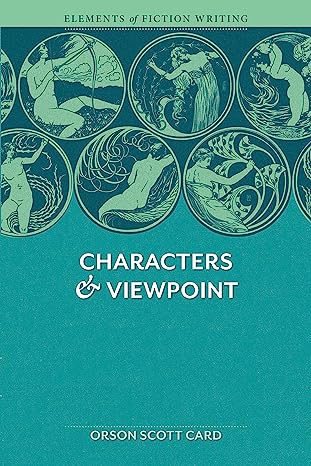
Orson Scott Card The table of contents alone promises useful insights: Characters are what they do, writing comic characters or serious characters, the levels of point of view, raising emotional stakes, how characters fit into types of stories (The MICE quotient), keeping character bibles, and more.
If you struggle with deep point of view and how to approach it, you definitely should look into this book.
-
Dynamic Characters: How to Create Personalities That Keep Readers Captivated
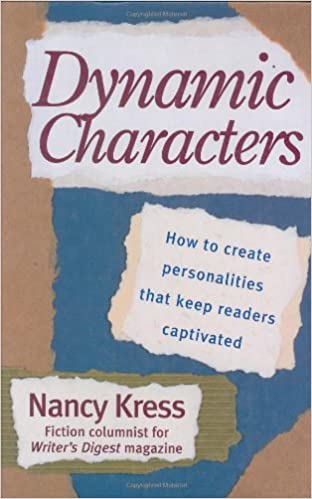
Nancy Kress A truly unforgettable story is defined by its characters. Their motivations, their changes, their actions compel us to read on, anxiously trying to discern what will happen next ... Blending physical, emotional and mental characterization, you’ll learn to create characters that initiate exciting action, react to tense situations, make physical and emotional transformations, and power the plot from beginning to end.
Worksheet: The Intelligence Dossier
Chapter 15 has an "Intelligence Dossier," a series of character interview questions. I transcribed it and turned it into the worksheet linked above. If you use Scrivener or similar programs you may want to add it as a template.
-
Creating Character Arcs: The Masterful Author's Guide to Uniting Story Structure, Plot, and Character Development
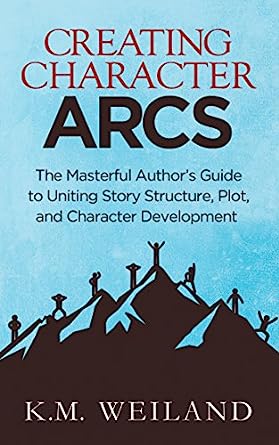
K.M. Weiland Positve arc -- go from zero to hero. Flat arc -- remain steadfast against all odds. And then there are the negative arcs: the Disillusionment arc of Nick Carraway in The Great Gatsby, the Fall arc of Heathcliff in Wuthering Heights, and the Corruption arc of Anakin Skywalker or Michael Corleone. Read all about how to structure each type.
This book comes with a workbook. You can also see Weiland's blog, Helping Writers Become Authors.
-
Crafting Unforgettable Characters
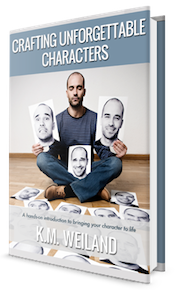
K.M. Weiland This is a free e-book you get when subscribing to K.M. Weiland's newsletter. It includes a character questionnaire for creating characters. Plus tips and resources for naming characters, advice on describing characters, considerations for their careers, guidance from Charles Dickens, writing prompts, and so forth.
See the link below for the character questionnaire from her book, which she linked on her website.
Additional: 100 Questions to Interview Your Characters
Names
-
The Society for Creative Anachronisms

I'm an onamastics nerd, so the selling point of this site for me is that they care about the etymology of the names and whether or not they were really in use during the relevant time periods / cultures. The SCA includes a wealth of cultures to get you started.
-
Celtic Personal Names of Roman Britain

Self-explanatory, these are the names used in Britain during the centuries when the Romans ruled them. Came in handy for me, you may also get some use out of it.
-
Jewish names from the Roman catacombs

JewishRoma.com Here are names taken from the catacombs used by Jewish people during the Roman era. They include Latin names, Greek names, Latin-Greek names, and Semitic names.
-
Lexicon of Greek Personal Names

Again, names that appear on this site were in use in ancient Greece, so if you have a story set there you may want to make use of this resource.
-
Avesta.org

If you're looking for names used in the assorted eras of Persia -- Elamite, Zoroastrian, Avestan, Irani, and Parsi, this is where you come to get them.
-
Iranian Culture Bootcamp: Titles and How to Address People

Titles of address / honorifics used by Iranians. Pontia, the blogger behind the site, is from Alabama and has lived all over the world. As an Iranian-American she easily makes learning about Iran more accessible. Look around the site for more fun and informative articles about Iranian culture.
On her YouTube channel, My Persian Corner, she teaches more about language and culture.
Design Documents & Story Bibles
If you plan on writing a series / saga/ or even a trilogy, you may want to create a bible for it. This is a document where you keep continuity information, such as detailed info on your characters, setting, magic, technology, lore, etc. And if you're making a video game, you'll need to make a design document, which includes the same type of information plus details specific to gaming.
-
Design Document Repository
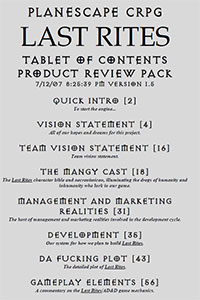
Curious how to write video games? This site is a respository of design documents you can use to get started. Diablo, Silent Hill, LucasArts games, Planescape: Torment, and so forth. The link also includes a list of links to video game pitch documents. Check it out for yourself.
-
TV Series Bibles

Assorted TV series bibles that you might want to study as templates. Includes He-Man, The New Girl, Grey's Anatomy, Star Trek: Deep Space Nine, BattleStar Galactica, etc.
Even if you don't intend to write for TV, these are still educational for worldbuilding, character building, story plotting, and so forth.
Language / Conlanging
In fantasy and sci-fi you will often see made up languages — Sindarin or Klingon anyone? These are conlangs, that is, they are constructed languages. Making up a language is called conlanging. I know of two ways to approach this feat: the Tolkien way, and the C.S. Lewis method. We all know Tolkien wholly constructed his languages of Middle Earth, which was probably an easy enough feat for a philologist like himself.
But if you've never spent even an hour of your life in a language class, you might want to take a look at the C.S. Lewis method: "Aslan" is Turkish for lion. Intrigued? And you might split the difference like I do, and take a word in an actual language and then tack on a suffix used in that language to make up a new word. I call a town "Asil'est" because asile is haven (well, sanctuary) and est is east in French. Then I smashed them together, dropped the E in asile and put in an apostrophe to signal the absent vowel. And bang: Asil'est. Bastard French à la Google Translate for "Easthaven" (the Romance languages often place adjectives after the noun). Fans of Icewind Dale will recognize the reference. Anyway. Look below for more options.
Conlanging
-
The Art of Language Invention: From Horse-Lords to Dark Elves, the Words Behind World-Building
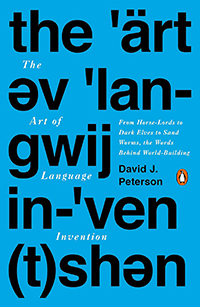
David J. Peterson While I haven't read this yet, the fact that it's written by the man who created the Dothraki language for Game of Thrones should be enough to pique your interest. Plus he has chapters on phrasing, including word order, negation, question formation, pragmatic concerns, relativization, and subordination, providing a complete introduction to language creation and linguistics. Invented languages featured in the book now include Chakobsa from Legendary’s Dune, Trigedasleng (or Grounder) from The 100, Méníshè language from Motherland: Fort Salem and Ravkan from the Netflix series Shadow and Bone.
-
The Conlanger's Library
Here you will find books, games, worksheets, and other resources focused on conlanging, courtesy of the Language Creation Society.
-
The Language Creation Society

Their goal is to further the art, craft, and science of language creation. In addition, you will also find a job board where you can hire a conlanger. Before you do so, you may want to take a look at "Working with Conlangers," the entry below, which has a primer that may help you.
-
Working with Conlangers
This is an informative blogpost from fantasy novelist Karen Myers on working with conlangers. May come in useful if you decide to go the Miles Vorkosigan route of never doing yourself what you can get an expert to do for you ;) Myers also has a three-part series on conlanging where she addresses conlanging from an author's point of view, and conlanging from the conlanger's point of view, so that both parties can be on the same page. So be sure to follow her links in the post.
Dictionaries
-
Akkadian Dictionary

Should be self-explanatory. They have a quick pronunciation guide for certain letters (when you see them you'll understand), and the entries always include the context in which the words were used in that language. Sprinkle a little here and there for your voces magicae — the scholarly term for magical nonsense words such as "abracadabra."
-
English to Greek Dictionaries
Perseus Digital Library I use this site when I want to look up ancient Greek terms for various concepts. Hosted at the Perseus Digital Library, this tool lets you search through A Greek-English Lexicon, by Henry George Liddell and Robert Scott, as well as Liddell & Scott's Intermediate Greek-English Lexicon and Georg Autenrieth's A Homeric Dictionary for Schools and Colleges among other sources.
If the Greek alphabet is ... Greek to you (sorry!) then go to the Display Preferences box, and where it says "Greek Display" select "Latin transliteration".
-
Online Etymology Dictionary

As a child I loved the lexiconic dictionary my parents gave me as a Christmas present, because it told me what language a word came from, when it sprang into existence, and what it originally meant. Here's a site that lets you do the same. You may find some interesting word origins that help you with your own conlanging / worldbuilding.
-
Latin Grammar
Allen & Greenough Allen and Greenough’s New Latin Grammar for Schools and Colleges, as presented by the College of Classical Studies at Dickinson College. Here is a helpful site to get you started on Latin declensions and more.
-
Lexilogos
From Abkaz to Zulu: This site is one-stop shopping for a ton of language dictionaries. I used it to find the ancient Greek dictionary hosted at Tufts University's Perseus Digital Library, but obviously there are many others you can consult.
-
Stack Exchange
You can find any number of topic communities here, including several focusing on languages, including English, French, and Korean, and linguistics in general.
Don't miss the Worldbuilding Stack Exchange, listed in the Worldbuilding Section
-
Wiktionary
I use this to find declensions, conjugations, and prefixes and suffixes for assorted languages. You can find enough to get the ball rolling to begin your own conlanging endeavors.
Toponyms, Ethnonyms, and Demonyms
What would you name the town where your people live? What do you call the people in your fictional coutnry? Is it related to the name of their ethnic group; e.g., Americans live in America, but you might have a Japanese-American because "American" is not an ethnicity it's a nationality. A Basque who lives in Spain or France is still Basque. And the Klingon homeworld is Qo'noS.
One way to convincingly conlang — even if you're just making up a fictitious Cabot Cove for a medieval French version of Cadfael — is to consider how place names are formed. If a city or town in England ends with -cester, -caster, or -chester that is a clue the place was once a Roman castrum — a military settlement. For example, Leicester, Colchester, and Doncaster.
In England a town on a river or coast might have "upon" in the name, e.g., the famous Stratford upon Avon. For France you would say "sur" for the same reason, e.g., Villefranche-sur-Mer (Villefranche on the Sea). And if a place is built on a summit expect to see "-mont" in its name, and "-val" if it's in a valley. Also in the French north a town's name might have a Norman influence, and thus the adjective and noun are "Neuville" (New Town), but in the south it would be Villenueve (literally, "town new," a.k.a New Town). Such prefixes and suffixes help you create place names, and your search keyword to find the relevant ones for your fictional culture is toponym.
If you wanted to construct an ethnic group name, look to ethnonym suffixes for inspiration. For example, the Bible is famously peopled with -ites: Canaanite, Israelite, Levite. The -ite is a Greek suffix used to turn a noun into an ethnonym or demonym. Canaanites are from Canaan, Israelites are from Israel, Levites are an Israelite tribe descended from Levi, the son of Jacob. Demonym refers to nationalities (because demos is Greek for "people").
An excellent source for finding out potential suffixes & prefixes is Wiktionary and Wikipedia. You will find many options there to get you started, for example the Wikitionary link goes to the page on French morphemes, where you can find a links to French suffixes and prefixes. Follow the "bread crumb" links to see the other languages. The Wikipedia link goes to a page on the toponomy of England. Watch this space for more detailed listings.
Narrative Structures
As I said above re: beat sheets, structural beats and narrative beats aren't the same, though they can be used together. Different genres have different events that occur at the structural beat. At the climax of a mystery, the detective solves the case / catches the bad guy. In a romance, the inciting incident may be "boy meets girl". So with that in mind, what follows here is a look at different narrative structures that may give insight to writing your own stories.
Plot Driven
-
Romancing the Beat

Gwen Hayes What makes a romance novel a romance? How do you write a kissing book? Writing a well-structured romance isn’t the same as writing any other genre -- something the popular novel and screenwriting guides don’t address. The romance arc is made up of its own story beats, and the external plot and theme need to be braided to the romance arc -- not the other way around.
-
Structure of the Gothic Tale
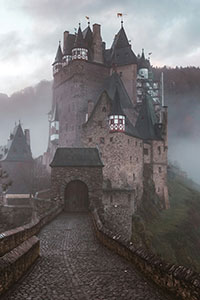
This comes from Ookami Kasumi's page at Deviant Art. I like the insight of gothic stories being about the shadows within, not without. You could have a gothic on a windswept moor, an old Southern plantation, or a derelict space station, but wherever your protagonist is, so will be the monster within.
-
Horror and Slice-of-Life
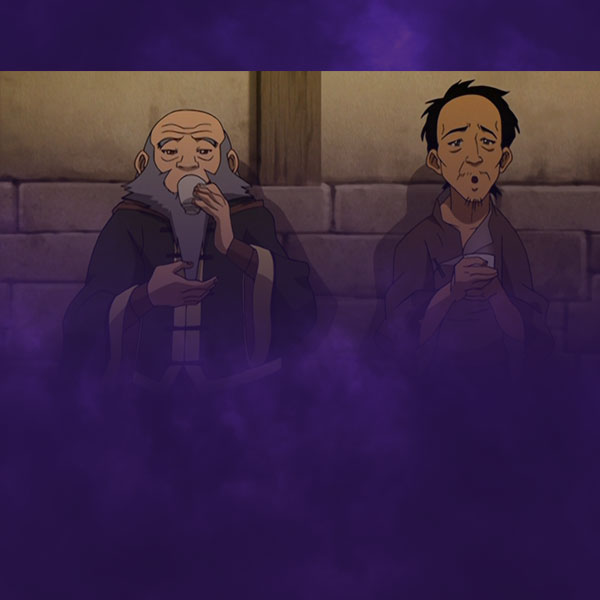
Kishōtenketsu structure may suit you for either type of story. Though the name is Japanese, this narrative structure is also used in the West, particularly in urban legends. In this post, I explain conflict-driven vs. causality-driven stories, and the usage of kishōtenketsu for the latter.
Character Driven
-
The Heroine's Journey

In this series I look at the Heroine's Journey, which can can also be called a Fairy Tale Journey, as opposed to the Mythic Journey of the Hero. This journey concentrates on obligations to the self, apart from a group: one’s own autonomy, self-worth, and identity. It underpins many exciting stories -- Captain America, classic Disney Princesses, video games such as Mass Effect 2, and Harry Potter. I go in-depth with the different varieties of Fairy Tale Journey, from Inanna to Psyche. Take a look.
-
Redemption & the Heroine's Journey
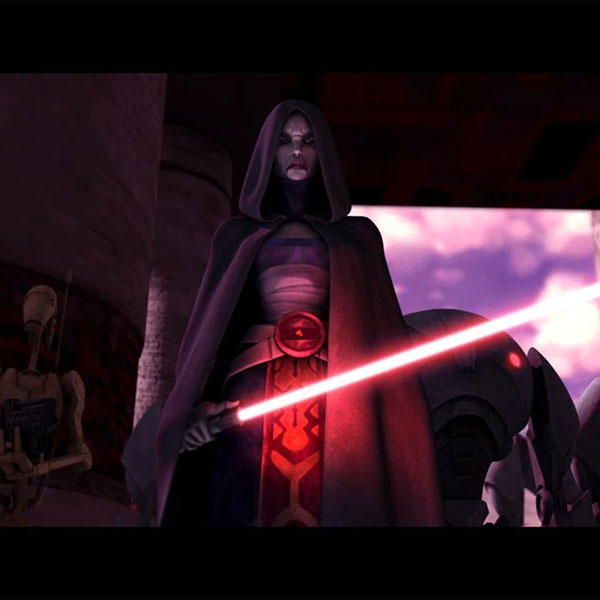
In this post, I look at how you can use Inanna's Descent as a scaffold to writing a character's turn from "the dark side." This is a case study of the redemption arc of Asajj Ventress in the 2008 version of "The Clone Wars" cartoon series.
-
The Sinner's Redemption

Hope Ramsay This one I retrieved from the Wayback Machine, and comes from author Hope Ramsay, who writes: Redemption tales usually begin with a protagonist who has already fallen from grace, or who, like the Ancient Mariner, commits a crime and falls from grace in the first few scenes. Unlike the Hero who start his story in an "ordinary world," or a Virgin who starts her story in a "dependent world," the Sinner begins his tale in a "miserable world."
Food for thought is that in a series or trilogy, Ramsey’s proposed structure might be used in a sequel to a book where the protagonist experienced the Negative Disillusionment Arc. The Sinner’s Redemption does not begin with a betrayal, unlike redemption arcs fueled by Inanna's Descent.
Narrative Techniques
How do you write emotionally resonant scenes? How do you write love scenes? What about dialoge, point-of-view, and the all-important but elusive technique of subtext? I've got you covered, and I've included resources specific to assorted genres as well.
Let's start with the general resources.
General Narrative Techniques
-
Write Away: One Novelist's Approach to Fiction and the Writing Life
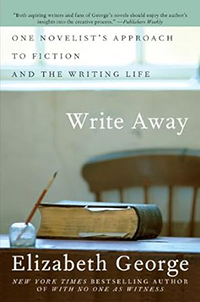
Elizabeth George Elizabeth George, author of the Inspector Lynley mysteries, gives a detailed overview of how to write novels, with attention to craft, from setting to plot, to techniques, including style and grammar, and the writing process.
Many thanks to her revolutionary lesson on THADS: Talking Head Avoidance Devices, which deepen scenes and subtext by going beyond mundane action beats like "he nodded," or "she raised her eyebrows," or "he sipped his tea." A good THAD brings a scene to life and reveals inner character. I always loved George's THADs even before I learned her term for them.
-
Mastering the Process: From Idea to Novel

Elizabeth George Using her own novel as a case study, George gives writers "practical, prescriptive, and achievable tools for creating a novel, editing a novel, and problem-solving when in the midst of the novel."
-
The Emotional Craft of Fiction: How to Write the Story Beneath the Surface

Donald Maass Literary agent Donald Maass delves into how to connect readers on a visceral level to the characters in your story. He'll show how to create an emotional response via showing and telling, identifying the moral stakes that result in character's changing, weaving a character's inner journey with the outer journey, and more.
-
Techniques of the Selling Writer
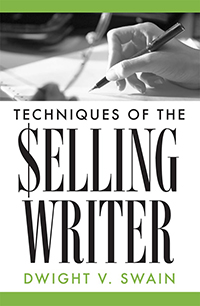
Dwight V. Swain You'll find what's in here referenced in writing advice all over: the motivation reaction unit, scene & sequel, incidents & happenings. What is every scene? That is where the goal, conflict, and disaster comes in. What is a sequel? The reaction, dilemma, and decision made in response to the scene? Where to place a flashback? In the sequel. When's a good time to summarize events versus a full-blown scene? With Incidents & Happenings. Check this out.
Genre-Specific Techniques
-
The Ultimate Guide to Video Game Writing and Design
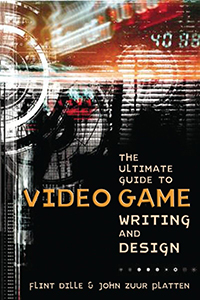
Flint Dille & John Zuur Platten The co-writers for "The Chronicles of Riddick: Escape from Butcher's Bay" cover how to create worlds and environments, multi-level dialogue, how to present your designs to developers and publishers, how to create a high-level design document, and working with licenses vs. rolling your own IP.
-
I Give You My Body: How I Write Sex Scenes

Diana Gabaldon The author of "Outlander" shows how she writes the steamy scenes her fans love. In addition, you'll learn the difference between gratuitous sex and genuine encounters that move the story forward, and how to handle less-than-savory acts that nevertheless serve a narrative purpose. Don't write romance? This book is still worth studying for lessons on weaving in sensory details in a scene. Plus, how to evoke a mood to using the power of emotions to communicate physical intimacy.
-
Writing Mysteries: A Handbook by the Mystery Writers of America

Edited by Sue Grafton Tony Hillerman on pantsing, Robert Campbell on planning, vivid villains by Sandra Scoppettone, Phyllis Whitney on pacing and suspense, advice on clues and red herrings by P.M. Carlson, writing YA mysteries by Joan Lowery Dixon — all of this and more. I gather there was a second edition in 2002, which you may want to look into, as there are more authors included.
There is a 21st century edition (2021) edited by Lee Child & Laurie R. King, with contributions by Tess Gerritsen, Jeffrey Deaver, Kelly Armstrong, and additional subgenres such as historical mysteries (Jacqueline Winspear) and graphic novels (Dale W. Berry and Gary Phillips), and updated advice on self-publishing, legal matters, and marketing.
Additional: How to Write a Mystery: A Handbook From the Mystery Writers of America -
Writing the Thriller: How to Craft Page-Turning Suspense with Instruction from Best-Selling Authors
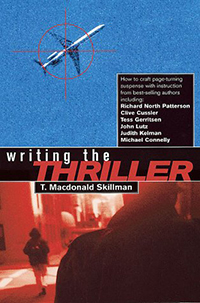
Edited by T. MacDonald Skillman How to craft page-turning suspense with instruction from Clive Cussler, Tess Gerritsen, Michael Connelly, Marilyn Wallace, Richard North Patterson, and more. They cover action adventure, romantic suspense, techno-thrillers, and psychological suspense among others.
-
How to Write Tales of Horror, Fantasy and Science Fiction
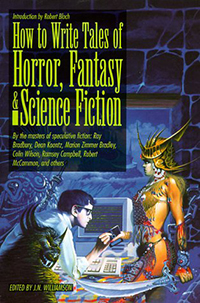
Edited by J.N. Williamson A lot of the advice in this book has stuck with me since I first read it as a teen. The late Sharon Baker on writing science fantasy, Ardath Mayhar on creating fantasy races, Dean Koontz explains why horror must do more than frighten, Darrell Schweitzer on sword and sorcery, plus contributions from Ray Bradbury and an amusing cameo by Harlan Ellison. As a kid I made a point of seeking out the novels and short stories the authors recommended.
Technique: Dialogue
-
She Sat, He stood: What Do Your Characters Do While They Talk?

Ginger Hanson Above I mentioned Elizabeth George's lessons on Talking Head Avoidance Devices. Coming up with good THADs is easier if you pay attention to mise en scène: that is, the setting for the scene and what "props" are there for characters to interact with. As well as the characters' body language. Ginger Hanson not only covers all of that, but she also includes vital instruction on formatting dialogue beats.
At her website Hanson also has resources for writers, and supplemental material for her book. Check them out
Additional: Ginger Hanson's resources for writers
-
Using Turning Points to Nail Exposition
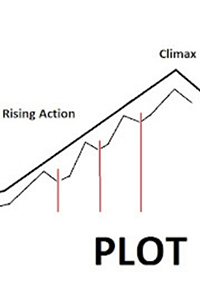
September C. Fawkes "When trying to decide what information to leave in or out, ask yourself: What does the audience need to know to make the turning point most impactful?" And in some cases, you may even dare ask, "what needs to be withheld from the audience to make the turning point most impactful?"
-
The Key to Writing Freakishly Good Dialogue | Video Essay

Local Script Man, aka Lucas Strunc Thesis: You have a giant pile of info, but your character acts as a filter. How would THIS character in THIS situation communicate THIS information? And without on-the-nose dialogue and info dumping? Also covers subtext, and the fact that disagreement does NOT equal conflict, and avoiding the contrived "alleyoop line."
Though Strunc comes from the world of TV & movies, his tips are adaptable for prose writers.
Technique: Subtext
Subtext: the secret ingredient that gives dialogue that extra zing and adds spice to character interactions and dialogue. But a lot of would-be instructors on the topic have trouble explaining it. The ones I'm linking to gave clarity and actionable tips, and I hope they work for you, too.
-
The Only 5 Ingredients You Need for Story Subtext

K.M. Weiland I've seen other writers try and explain subtext, but their examples were like nailing smoke and steam to me. It's easy to aim for subtext, but instead land on vague at best and non-existent at worst. Weiland gives five amazingly clear principles that should help any writer level up.
-
Undercurrent vs. Subtext vs. Theme

September C. Fawkes In this post, Fawkes refers to undercurrents not necessarily as the atmosphere, e.g., "an undercurrent of tension in her demeanor" but rather the story beneath the story. She distinguishes undercurrent from subtext on the basis of the former surfacing to impact the plot from time to time, and becoming explicit at a given point. Worth a read!
In this post Fawkes also links to three other posts on subtext, theme, and undercurrents, so you may want to read those as well.
-
Obi-Wan Being Soft for Satine for 8 minutes straight

Star Toons This video is not an instructional video per se, but it's educational because it subtitles the subtext in the clips, which come from episodes of the CGI "Star Wars: The Clone Wars" cartoon series. What you need to know is that Jedi Knight Obi Wan Kenobi, and the pacifist Duchess Satine of Mandalore are star-crossed lovers who have been thrown together again when Mandalore is threatened by terrorists. The humor is derived from the subtext in both the dialogue and action beats.
-
How to Write Subtext in Dialogue

K.M. Weiland In Weiland's words, subtextual dialogue is the secret initiation rite of writing. It opens up a door to a whole new mansion of storytelling possibilities—everything from subtlety to irony to thematic significance. For a case study in subtexual dialogue she looks at "Captain America: The First Avenger," part of her series on the dos and don'ts of storytelling according to Marvel.
Don't miss her post on the five key elements required to create subtext in your novel. This was the clearest example I'd ever seen on the topic, and helped me immensely.
Additional: The Only 5 Ingredients You Need for Story Subtext -
How to Write What's Not Written (Subtext)

September C. Fawkes Key quote from the post: "It's strange, but often when we communicate our feelings directly, we lose tension. It's what's not being said that creates tension. It creates anticipation and apprehension, keeps us interested because of what's boiling under the surface."
World Building
Your character walks into a tavern. What is served? And what does it taste like? What music is playing while they eat and talk? What do they wear? If they get into a fight, what weapons will they use? Can your Robin Hood / Katniss fire an arrow that has a message attached? Can your adventurer keep his sword in a sheath on his back, and do stunts without it falling out? If you were inspired by Patricia C. Wrede's worldbuilding questions — which are linked below — get some answers here.
Food
-
De Re Coquinaria

The classic Apicius cookbook, for use if you're have an ancient Roman setting and all you know about Roman cuisine is that it involved stuffed dormice and garum fish sauce. I personally borrowed the violatium (violet wine). Pictured at left is the fine spiced wine, from the Conditum Paradoxum episode of Tasting History with Max Miller.
-
Game of Brews
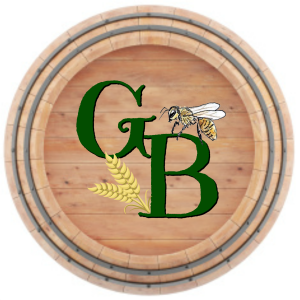
Hippocras. Violatium. Plum wine and usquebath--these are just a few of the recipes for the drinks of old. In addition, you'll find drinks that live only in the pages of fantasy, such as the white mead of Galadriel. Check it out.
-
Tasting History with Max Miller
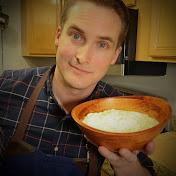
Max Miller jaunts from the Apicius cookbook of ancient Rome to Fanny Farmer. You get Roman garum, bierocks from Volga Germans, kykeon from the Iliad, flower pancakes from 17th century Korea, and hot chocolate from Aztecs. Dive in.
Miller has a cookbook based on recipes from his channel, and the link is included in every video. Read the comments on the videos; I loved the one from the Icelandic viewer who talked about which volcano they use to bake bread. "That volcano is too cold, so we only use the one next to it."
-
Table of the Gods

Uncovering the world’s oldest recipes, cities, and stories from ancient Mesopotamia. I appreciate how well the host, Arim Hawsho, organizes the content on his channel. Hawsho is a Swede with Assyrian heritage, and he's all about "The Cradle of Civilization" with engaging videos about the foods his ancestors would have enjoyed.
Hawsho also has a book coming out, so check out the links posted on his videos. I love the beer-tasting episode, comparing the Mesopotamian beer to the modern beers available in Sweden. I like lambics (Belgian fruit beers) and tej (Ethiopian honey wine), so I got a kick out of seeing the face off.
Music
-
Peter Pringle

The host of this channel, Peter Pringle, plays ancient instruments such as the kithara and the lyre. He recreates the music of ancient Sumer, Greece, Egypt, and India. And even made-up instruments, like Mr. Spock's Vulcan harp, and modern-but-strange instruments such as the theremin.
History
You may have noticed Patricia Wrede's famous Worldbuilding Questions in the Worksheets section. If they look daunting to you, here's a little secret to writing fantasy / sci-fi: pick a culture, historical era, myth or folkore that grabs you by the throat and won't let go.
If you're fond of Renaissance France, Heian-era Japan, pre-Columbian Meso-America; if you can't get enough of Egyptian myth or Russian folklore -- use those as your starting points. Jump off from there.
Game of Thrones is famously "The War of the Roses" with York converting to Stark, and the Lancasters becoming Lannisters. This works for sci-fi, too: David Weber's Honor Harrington series is nicknamed "Horatio Hornblower in Space," with Harrington's Manticoran Navy as a stand-in for the Brits, and the Peeps (People's Republic of New Haven) being a stand in for the French during the Reign of Terror. The selling point is that you know where to start and end with research, and you will have a basis to turn your fantasy / sci-fi culture into something that lives and breathes. With that in mind, here are some general resources to get you started.
-
The British Museum

This channel has a Smörgåsboard of offerings. My entry point was the episode about brewing and taste-testing ancient Egyptian beer (part of their Pleasant Vices playlist), and I'm seeing a ton of content that may come in handy.
-
Dan Davis History
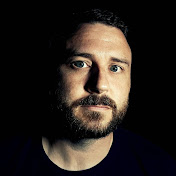
This one is new to me, but it came highly recommended and I already see several videos on this channel that interest me. Take a look, he deals a lot with the pre-historic world.
-
Internet African History Sourcebook
Fordham University Brought to you by the editor behind the Internet Ancient History and Medieval History sourcesbooks, you can find here texts on ancient and medieval kingdoms in Africa, in addition to modern history.
They also have sourcebooks for the ancient era, modern history, East Asia, India, and more.
-
Internet Ancient History Sourcebook
Fordham University They have a lot of goodies here. For ancient history they include sources for Egypt, Greece, Rome, Mesopotamia, Israel, Persia, Late Antiquity, and early Christianity. Per the site's intro, "the goal here is to provide and organize texts for use in classroom situations. Links to the larger online collections are provided for those who want to explore further."
They also have sourcebooks for the Medieval Age, modern history, Africa, East Asia, India, and more.
-
Internet Medieval History Sourcebook
Fordham University This one covers the end of Rome, Byzantium, Islam, the Roman church, Anglo Saxons, Early Germans, the Celts, Carolingians, and so forth into the Renaissance era.
They also have sourcebooks for the ancient era, modern history, Africa, East Asia, India, and more.
-
Invicta
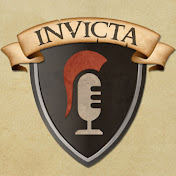
I can vouch for the quality of their source materials where they discuss stuff I've studied, e.g., magic in the Greco-Roman era. So I settle in and enjoy when they talk about stuff I'm not familiar with; e.g., the famous Naumachia battles of the Coliseum, or every day matters like how crime investigations were conducted in ancient Rome, to life in Carthage.
They team up with other YouTube channels such as Imperium Romanum when they want to show live re-enactments, and Tasting History with Max Miller when it comes to food, so you may find more sources than I've listed here.
-
Livius
Another ancient history resource I like to use. It began as the project of Dutch historian Jona Lendering, it focuses on Greece, Persia, North Africa, and the Levant, in addition to Nubia and Sumer.
-
The Metropolitan Museum of Art: Heilbrunn Timeline of Art History
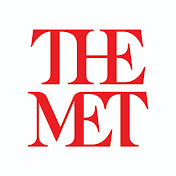
This online collection has been useful for me. In addition to art, the Heilbrunn has informative primer essays on a variety of topics. Pick a culture, era, medium -- they've got something to get you started, or generate a plot bunny or two.
On the homepage of the Met, you can see a menu link titled "Learn With Us", which has a link to more articles, videos, and podcasts.
Additional: Met Perspectives -
Modern History TV
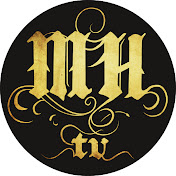
Jason Kingsley OBE, the Modern Knight, investigates the medieval world. We aim to test out what it was actually like. Books are great but getting out and trying things is even better. Jason owns and trains his own horses, fights in medieval armour and tests people's theories to destruction. Cool description, no?
-
Perseus Digital Library
Tufts University I come here as a quick and easy source for classical texts, e.g., Pliny the Elder. You can also find art and archeological images here. While their initial focus was the classical era, their collection also includes Arabic, German, and Renaissance-era texts.
-
Resources for World Builders

The blog is called A collection of Unmitigated Pedantry, and he has all kinds of interesting content, including critiques of the Fremen of Dune and the Dothraki of Game of Thrones. On this page, you will find resources for aspects of worldbuilding: pre-modern economies and how they worked, armies and logistics, religion, society and politics, armor and weapons, and ship designs.
The blogger, Dr. Bret C. Devereaux, is an ancient and military historian who currently teaches at North Carolina State University. He's a fan of sci-fi and fantasy as well, hence the critiques of fictional barbarians.
-
Royalty Now Studios

What did Boudica, Cleopatra, Augustus, King Tut or Pocahantas actually look like? On this channel they take stab at re-creating the true appearances of historical figures based on known paintings, sculptures, or descriptions. Frequently, they will "update" the historical personage by showing what they would look like in modern attire. Very cool.
-
Shadiversity
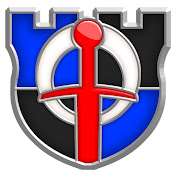
Can your Robin Hood fire an arrow with a note attached to it? Can your adventurer draw a sword from a sheath strapped to their back? What about, *ahem*, "boob armor"? Just how effective would the whip of Indiana Jones be in real life? Shad, the channel host, explores, creates, and tests answers to these questions and more.
-
World History Encyclopedia

A multimedia website of history. My go-to for an assortment of subjects, although I've been concentrating on the ancient world.
I just recently discovered they have a YouTube channel, which I'm linking below. The videos are published to YouTube every Tuesday and Friday.
Additional: World History Encyclopedia -- YouTube edition
Planetary World Building
Whether you're writing science fiction or fantasy, or my favorite, science fantasy, you may want to know how to build a credible planet and solar system for your story. I will be adding more to this later, but for now here are a few things to get you started.
-
arXiv
Hosted at Cornell University, arXiv is repository of science papers I found useful when I was creating a sci-fi cookbook for potential habitable worlds. It has up-to-date scholarly PDFs on the most recent data on the Kepler mission to find habitable planets. This link goes to the results of a basic query, "habitable planets". FYI in case it matters, none of the papers are peer-reviewed.
-
World-Building: A Writer’s Guide to Constructing Star Systems and Life
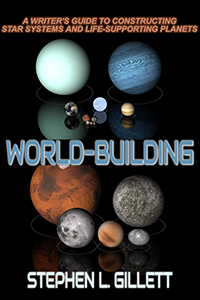
Stephen L. Gillett Years ago Writer’s Digest put out a science fiction writing series edited by Ben Bova. This book is one of them. I now have it in Kindle form, and it's a definite keeper.
-
The Writer's Guide to Creating a Science Fiction Universe

George Ochoa and Jeffrey Osier I spent hours pouring over this book as a teenager, designing the solar system for a colony-in-peril story I was writing back then. I had a particular obsession with giving Saturnian rings to habitable worlds; I still think that would be cool. Anyway, the book is very readable for beginners and helpful for spinning up a sci-fi cookbook. Sadly out of print, but available used.
Weapons & Warfare
-
ARMA -- The Association for Renaissance Martial Arts
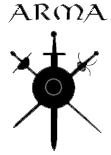
I found some good info here. They include historical fighting manuals as well. From their own site they say they are, "an educational non-profit organization dedicated to the study and practice of historical fencing and the exploration and promotion of our Western martial heritage."
-
Schola Gladiatoria
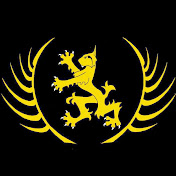
Matt Easton of Schola Gladiatoria covers military history from all periods, ancient to medieval to Victorian and WW1. Fencing, combat sports and martial arts, antique swords, militaria and weapons, armor, sword reviews, movie and TV fights, Sci-fi and fantasy weapons, and more!
General Worldbuilding Resources
These are not always worksheets; the ones that aren't may be reference guides if you intend to make your own worksheet; for instance, Patricia Wrede's worldbuilding questions.
-
Fantasy Worldbuilding Questions By Patricia C. Wrede

Damn good questions I myself pondered when I set out to write my own fantasies. Wrede herself said most writers add, not subtract from the questions she poses here. I copied these and turned them into a Scrivener template sheet. Based on the copyright notice at the SFWA and Wrede's own site I cannot share my copy, but you could make one for your own personal use.
Wrede also has these questions on her blog as well, along with other writing advice.
-
On Thud & Blunder
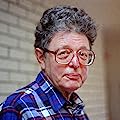
Poul Anderson Poul Anderson's primer on world building. Basic things one ought to know when setting out to write a fantasy, especially one based on medieval Europe in particular: An English king can only summon farmers to fight his battles at certain times of the year. There's a reason RPGs have the player character build roads whenever they are presented with a stronghold to manage. Horses are not like cars, etc. A must read, check it out.
-
Worldbuilding Stack Exchange
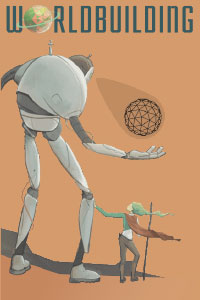
You have questions: what does dragon blood bring to the table if you want to use it when forging swords? Do you want to vet how to make a fantastical idea scientifically plausible? Worldbuilding Stack Exchange is a Q&A site for writers/artists using science, geography and culture to construct imaginary worlds and settings. This site pops up often in my search results; someone has usually asked a question I'm asking in my head. Join them if you want to pose a question of your own.
